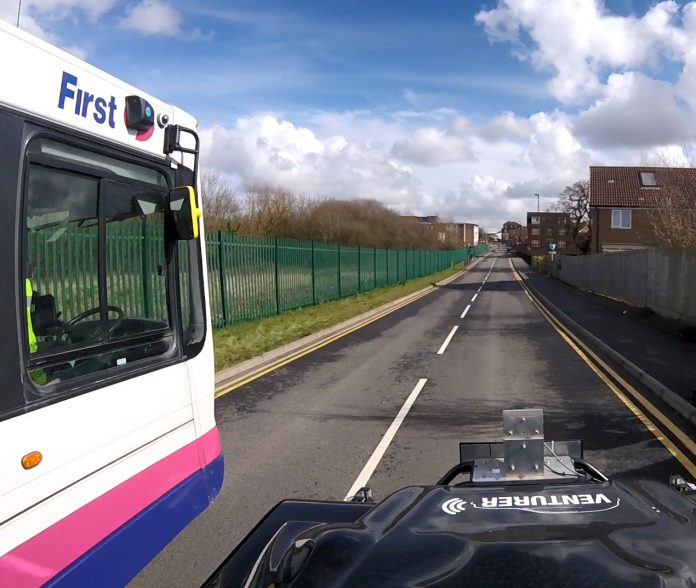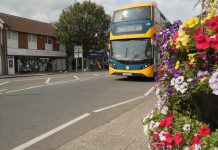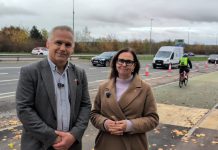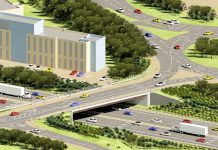The VENTURER consortium recently carried out a pioneering driverless vehicle demonstration involving wireless communication between a bus and car which tested ‘look ahead’ functionality.
In March, VENTURER undertook the UK’s first on-road demonstration of a driverless car interacting with a bus. The innovative trial was the first of its kind and took place on Long Mead in South Gloucestershire, a 30mph bus only road that follows the south west perimeter of UWE’s Frenchay campus.
The demonstration involved the VENTURER Wildcat (a BAE vehicle equipped with connected and autonomous technology), a single decker bus provided by First Bus UK and another unmodified vehicle. The aim was to test ‘look ahead’ functionality, where the autonomous system, including sensors (provided by Fusion Processing), a wireless communications system (provided by the University of Bristol) and the vehicle’s Decision Making System (DMS) (provided by the Bristol Robotics Laboratory), enabled the Wildcat to be notified that the road ahead was clear so the vehicle could then safely navigate around a stopped bus despite having obstructed vision. Another scenario was undertaken when there was no oncoming vehicle and the Wildcat was able to make an immediate ‘go’ decision to continue around the bus without the need to stop.
We are one of the VENTURER consortium members and as well as being the responsible Highway Authority, council officers facilitated the necessary legal requirements to carry out the demonstration on Long Mead, which is usually a bus only road.
Leader of South Gloucestershire Council, with responsibility for economic development in the Cabinet, Councillor Toby Savage, said: “As a local authority, we are proud to be one of the country’s leading centres for innovation and at the forefront of connected and autonomous vehicle (CAV) research and development. As a place where industry and research institutes are already choosing to innovate, we are open to providing the infrastructure, platforms and resource at our disposal to support innovation.
“Our involvement in projects such as VENTURER brings us invaluable learning at no cost to the local council tax payer, and should help us be better prepared for the future and maximise on any associated cost savings. This experience also puts us in a position to advise other local authorities and organisations.”
VENTURER Project Manager, Carolyn Mitchell of Atkins said: “We believe that this aspect of Trial 3 demonstrates great project progression and puts the West of England at the forefront of CAV testing in the UK. To our knowledge no other UK CAV projects have yet tested autonomous technology interactions between a CAV and a bus.
“The bus demonstration represented a step change in technical, safety and management challenges due to its location on an open road and the resulting potential for interactions with members of the public and their vehicles.
“The success of the demonstration shows the successful collaboration between VENTURER partners to deliver safe and innovative real-world tests of a range of connected and autonomous technologies.”
Managing Director of First Bristol, James Freeman, said: “As a bus operator we have a very keen interest in technology, whether this is to improve our customers’ journey experience through smarter ticketing, reduce vehicle emissions, improve the efficiency of our fleet and operations or indeed technology to improve road safety.
“We are involved in various innovative projects taking place in Bristol, and our interest in VENTURER is mainly to understand developments in autonomous vehicle technology, and in particular how sensor technology installed on bus vehicles could make roads a safer place for other road users. This is not a new development: We are currently in the process of installing an innovative safety feature called CycleEye on Metrobus vehicles, developed by Fusion, which will alert bus drivers when cyclists are on the near side of the vehicle.”
The bus demonstration has shown an example of how connected and autonomous technologies can be used on different types of vehicles to complement and support the safe performance of CAVs as part of the wider transport network. The demonstration was one of the first explorations of the interaction between connectivity and autonomy, with many other trials in the UK focusing on either connectivity for driver advisory systems or autonomy for self-contained automated driving. The demonstration was part of the third VENTURER trial which also comprises participant trials, the results of which will be published in June.
We are involved in the VENTURER project to build on the region’s legacy of aerospace and transport technologies and to be better prepared for any future advancements with CAVs. We have a wealth of hi-tech businesses and a skilled workforce in South Gloucestershire and we want to support these to grow, particularly in our enterprise areas. We also want to inspire the engineers of the future through these innovative science, technology, engineering and maths (STEM) activities.
We are currently involved in four Innovate UK funded research & development projects looking at driverless vehicle technology. We are a collaborator in these projects to facilitate demonstrations of connected and autonomous vehicle technology on our highway network and in campus environments. The learning from these projects can be used to help inform the council’s own aspirations around supporting connected and autonomous technology, in both highway and non-highway environments.
New modes of transport (especially for first mile/last mile) will increasingly utilise such technologies, potentially creating more efficient, safer and economical ways for businesses, visitors and commuters to travel. A shift away from personally-owned modes of transportation and towards mobility solutions that are consumed as a service, have the potential to radically transform the transport system in the longer-term future.
These projects also present opportunities around making better use of existing transport models of the region to provide CAVs with better understanding of the area as well as using historic count data to allow better understanding of how the network will operate under different circumstances. A further strength for the region is its increasing use of open data, including in the field of transport, which opens up possibilities for the ‘rules of the road’ to be made available to CAVs in machine readable formats in the future.
A Trial 3 film including footage of the VENTURER bus demonstration in action is available at VENTURER video
Further information on trials, public demonstrations and blogs are also available on the VENTURER website, and you can follow us for updates on Twitter @Venturer_cars









